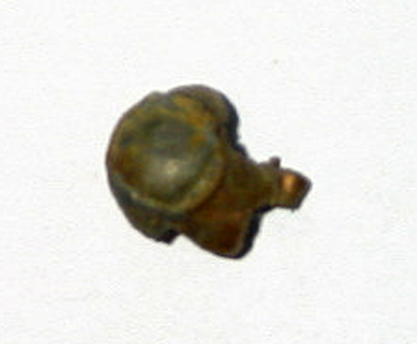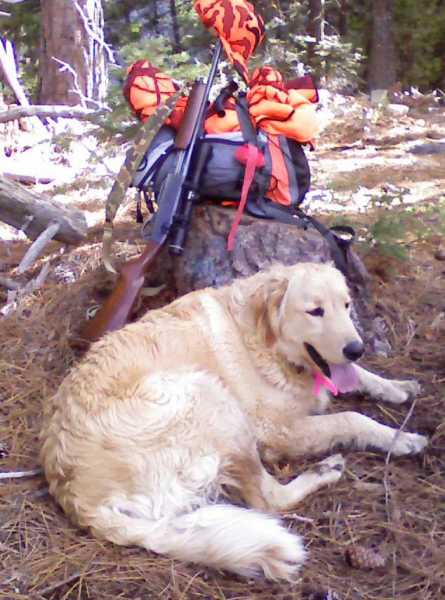While I always wanted to load the 130-grain Nosler PT in the .270 I could not afford to do so. For a long time in my fascination with retained velocity I loaded 130-grain Remington Bronze Pts. and killed a fair number of deer with them. The Bronze Pts. normally would blow-up inside the chest cavity destroy heart and lung tissue, and at times part of the liver. In this condition the deer might go a 100 yards, leaving a few dime size blood drops. The problem would come when the deer would rolled down the hill a few hundred feet out of sight. I never recovered a mushroomed Bronze Pt. just fragments.
The Remington 130-grain C-L under the same conditions when the bullet was place at an angle behind the shoulder would penetrate the chest cavity and muscle on the off side shoulder to be found under the hide. I cannot find any of those old bullets but suspect retained weight was around 20 percent.
The Hornady 130-grain SP was a bullet I really came to like in the .270 Winchester for use on antelope and deer. A favorite load was 60.5 grains of WW785 with this bullet. Even at long range it would completely penetrate a large antelope, leaving a large exit wound.
Normally I would find the 130-grain bullet in similar condition as pictured on the far side on deer. The one pictured was a behind the shoulder shot around 145-150 yards. The deer may have run fifty feet before dropping. The load was 59 grains of original 4831, or H4831 to the youngsters. When fired from my Savage 110CL with a 22-inch barrel the velocity is approximately 3015 fps 15-feet from the muzzle. This was at approximately 6700-foot elevation. **** I should note that IMR 4831 is a faster burning powder and should not be substituted for H4831. The recovered bullet retained 84 grains.

Before I started loading the Hornady bullet I purchased a Savage 110CL in .270 Winchester. In theory it became my open country rifle and the Remington M760 became my heavy cover rifle. At the same time I was becoming jealous of my buddy who was shooting deer with 165 and 180-grain bullets in their -06 and have an easier time tracking because of the increased blood flow. I all ready knew that my woodsman friend and logger Fred had been successfully using the 150-grain Remington C-L in his .270 Win. on deer for many years. In the kid years I was not impressed with the bullet because of itís published velocity, and round nose compared to the racy Bronze Pt. But I could not deny Fredís success. I had some learning to do!
I happen into a sporting goods store that had some 150-grain Norma Match bullets on the bargain shelve. At the time l lived at a location where I could try my loads a few hundred yards from the house and there would be no complaints. After following the recommendations I settled on what at that time was a middle of the road load. Today it is considered a near maximum load in a number of manuals. My final hunting load using 150-grain Norma Match, 150 grain Remington C-L, and 150-grain Hornady SP is 56.5 grains of H4831 in Remington cases, and using CCI standard large rifle primers.
The immediate plus side to the 150-grain Norma was a good exit hole with blood and other debris on the ground. The Norma bullet was designed for Match and not hunting use. It was common to find the jacket hanging in the hide next to the exit hole.
To insure good functioning in the Remington M760 I purchased five twenty round boxes of primed brass just for hunting. This has been very effective ammunition and I use other brass for practice. I still have few loaded boxes set aside for hunting.
The next big bargain came when I found a number of boxes of Remington 150 grain C-L on sale at a sporting goods store. I have not recovered any from a deer because they fully penetrate a deer, along with Hornady 150-grain bullet. Now days my bullet of choice is the 150-grain Hornady because of itís better long range characteristics.
My average velocity across the Chrony at 15-feet from the muzzle at 6700 foot elevation using a Savage 110 with a 22-inch barrel gave the following.
H4831 56.5 grains 150-grain Hornady SP Rem Cases CCI200 primer 2893 fps
H4831 56.5 grains 150-grain Rem-CL Rem Cases CCI200 primer 2884 fps
The average velocity with the 150-grain Hornady on the same day was 2831 fps from my Remington 700 with a 22-inch barrel.
When I tested the 150-grain Serria BT I had to drop down to 56.0 grains of H4831. I did not have a Chrony at during this period.
I had a few boxes of factory WW 150 grain power point loads. I was going to shoot it up and reload the brass because I was not satisfied with the accuracy in the M760. I had a new scope for the M700 and started shooting the ammunition. It was very accurate in the M700 and I decided to hang on to it for hunting. The picture of the recovered bullet in my earlier post is a 150-grain PP that provide about 25-inches of penetration in a frontal shot on a mule deer. While disappointed in the velocity the end results were outstanding.
Factory Winchester-Western Super-X Power Point 15 feet from muzzle gave 2727 fps when fired out of my Remington 700 barrel.
Some older Factory loaded Hornady Frontier brand 150-grain gave me 2809 out of my Savage 110.
The nice thing about my 150-grain loads is that all three rifles like them.
Now days when I go hunting with the M760 it is loaded with 150-grain bullets. The Remington 700 is loaded with factory 150-grain WW ammunition.
I love my Savage 110CL in .270 Winchester, I purchased it over 40-years ago and it been my long-range deer rifle and antelope rifle. It has proven accurate and effective with 130-grain bullets.
When Hornady came out with its 140-grain BTSP for the .270 I jumped on the bandwagon because of its ability to retain long-range velocity and energy. I started working up a load using H4831 and settled at 57.2 grains for a velocity of 2868 fps. I had tried a little more because the published maximum was 59.9 grains. My rifle would not come close to that using H4831 and I backed off to where I was comfortable, and had an accurate load. Of course the next challenge was to try the load on deer. I climbed out on a rocky perch that over looks and area covered with sage, a few trees, and Mountain Mahogany. A good place to get a shot out over 400-yards. Before I could settle in I heard the rattle of rocks below me and spotted a buck taking off. I almost needed a fire extinguisher to put out smokes in his fir. The bullet did its job and put the deer down. Later examination showed the bullet broke up on the spine, but did massive damage. Fragments of bullet were recovered. A little longer barrel and I could have made a contact shot, so it is hard to judge the bullet because of the close range.
I was not satisfied with the H4831 load, and started looking for data using WW785 Ball Powder. (Now discontinued) I found what I wanted in the Hornady 3rd Edition and purchased it. WW785 is a little slower burning then H4831.
I did not have a Chrony at the time, but I spent a summer on load development and testing. The closer to the published maximum the more accurate the load became and it exceeded H4831 in the accuracy department. The maximum load in the manual is 59.4 grains. I loaded to that level without any problems but dropped back to 59.3 grains. I tested the load at my low elevation shooting spot on 90į days without a problem. I then tested at my high elevation shooting range and obtained an average of 3030 fps out of the Savage 110 barrel. I then loaded and tested the load using Remington Nickel cases. I did this to identify this accurate load so that they would not get shot-up for non-hunting purposes.
A few years ago I had the chance to buy a good supply of discontinued old style WW 140 grain, boattail Silvertips. This is the old style aluminum tip, not the current plastic tip bullet. I read an article about these bullets years ago written by Rick Jamison. (sp) I ran out and purchased some Winchester BALL WMR Powder (Winchester Magnum Rifle) because they had dropped WW785. I started my load development process using information from a Winchester data sheet, and Hornaday 7th Edition. At this point I have stopped my load development at 57.8 grains of WMR. Velocity is recorded as 2917 fps from the Savage 110 at 3500-foot elevation. This produced a 3/8-inch group. I lost the daylight needed to make the Chrony operate but as a point of comparison I had earlier fired a round using 58.0 grains of WMR in the Remington 700 and the Savage 110. Both rifles have 22-inch barrels. The 700 record an average velocity of 2866 and the 110 a velocity of 2909 fps.
A few thoughts crossed my mind regarding the 700, buy a 24-inch barrel, or buy another 270 Winchester with a 24-inch barrel. I was also sneaking looks at closeout ads on Winchester M70 rifles for a 270WSM. It was a good fortune that I did not see such an ad. There were some good prices on other calibers.
Frankly a 6.5X55 saved me from spending the extra money. I looked back on a buck I shot using a 140-grain bullet at 2550 fps. It was amazingly effective with a 140-grain bullet traveling at 300+ fps slower. My point is that you can take deer with any number of calibers, and rifles. My current Remington 700 is a keeper.
In my Dadís memory this year I carried his old Remington 722, 300 Savage bolt-action rifle hunting one morning. I had upgraded the scope, loaded the ammunition, and shot it a fair amount before the season. I was able to collect a nice buck with it, but when I leave the house next season I will most likely carry a .270 Winchester, and there is a fair chance it will be the M760 Dad gave me in 1957.
Thanks Dad.
